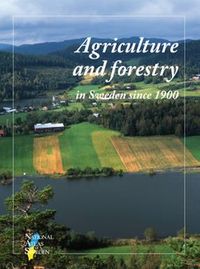
Agriculture and forestry in Sweden since 1900 - a cartographic description SNA
This atlas was made possible by a farsighted donation to the Royal Swedish Academy of Agriculture and Forestry (KSLA) from Moritz Fraenckel, a wholesale merchant, his wish being for the funds to be used a hundred years later for compiling a Swedish atlas. This atlas, with its 342 maps, 133 charts and 171 photographs, plus 59 other illustrations, describes the dramatic century that has passed. Farming and forestry have been transformed by mechanisation, motorisation, plant improvement, chemical pesticides, new knowledge on many different levels, economic and political change etc. At the beginning of the century, humans and animals provided most of the labour and implements were rudimentary. In the forest, the axe was superseded by the chainsaw and later by harvesters capable of felling, limbing and cross-cutting a tree in next to no time. Agricultural modernisation has been no less important. Farms which formerly depended on great numbers of workers such as bondagers, crofters and milkmaids can now be run by a handful of people, thanks to combustion engines and milking machines.
Agriculture and forestry provide us with foodstuffs, energy, building materials and paper – products essential to our daily living. This atlas puts present-day land use and its changes in agriculture and forestry into a historical perspective
Utgiven: 2011
ISBN: 9789187760617
Förlag: SNA
Format: Inbunden
Språk: Engelska
Sidor: 232 st
This atlas was made possible by a farsighted donation to the Royal Swedish Academy of Agriculture and Forestry (KSLA) from Moritz Fraenckel, a wholesale merchant, his wish being for the funds to be used a hundred years later for compiling a Swedish atlas. This atlas, with its 342 maps, 133 charts and 171 photographs, plus 59 other illustrations, describes the dramatic century that has passed. Farming and forestry have been transformed by mechanisation, motorisation, plant improvement, chemical pesticides, new knowledge on many different levels, economic and political change etc. At the beginning of the century, humans and animals provided most of the labour and implements were rudimentary. In the forest, the axe was superseded by the chainsaw and later by harvesters capable of felling, limbing and cross-cutting a tree in next to no time. Agricultural modernisation has been no less important. Farms which formerly depended on great numbers of workers such as bondagers, crofters and milkmaids can now be run by a handful of people, thanks to combustion engines and milking machines.
Agriculture and forestry provide us with foodstuffs, energy, building materials and paper – products essential to our daily living. This atlas puts present-day land use and its changes in agriculture and forestry into a historical perspective
Begagnad bok (0 st)
Varje vecka tillkommer tusentals nya säljare. Bevaka boken så får du meddelande när den finns tillgänglig igen.



